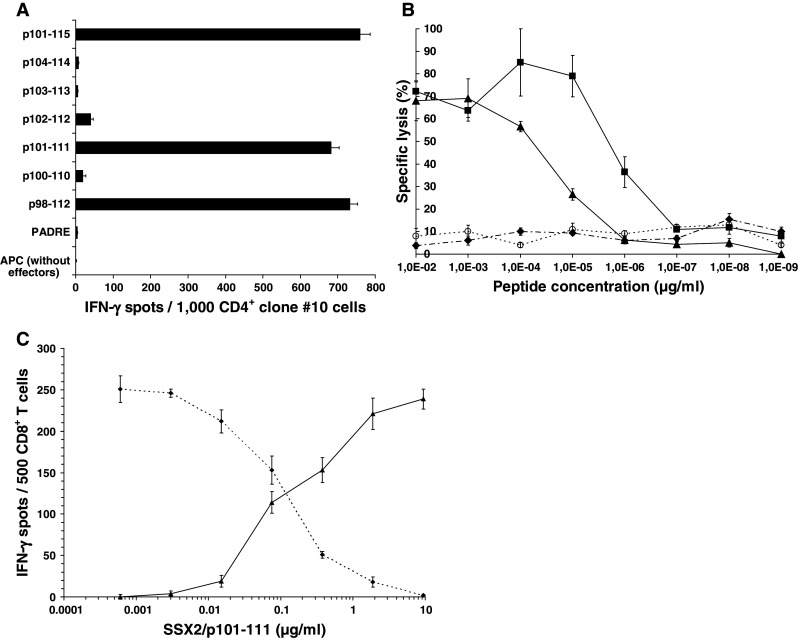Fig. 3.

Determination of peptide p101-111 as immunogenic core of the two peptides p98-112 and p101-115 and demonstration of the cytotoxic T-cell response against the core epitope p101-111. a After priming with peptide p98-112 CD4+ T cells of clone #10 (BC418) responded equally in IFN-γ ELISPOT when challenged with the pentadecamers p98-112 and p101-115 (P < 0.001) presented by allogeneic APC (3 × 104 LCL BC399/well). Peptide p101-111 was the only undecamer peptide to induce a response by clone #10 T cells (P < 0.001). Y axis displays the different APC settings used during IFN-γ ELISPOT. b HLA-A*0201-restricted CD8+ T cells from clone #24, which were generated by in vitro priming with the SSX2-derived nonamer p103-111, were used as effector cells in a CR51 release assay against HLA-A*0201+ T2 cells pulsed with decreasing concentrations of peptide p101-111 (triangles) or p103-111 (squares) by an E/T ratio of 10:1. Specific lysis of peptide-pulsed targets induced by clone #24 CD8+ T cells demonstrated a strong and dose-dependent cytotoxic T-cell response in an HLA-A*0201-restricted way. In contrast, the CTL epitope p41-49 (diamonds/dashed line), also derived from SSX2, as well as the DRB1*0101-restricted pentadecamer p98-112 (empty circles/spotted line) did not cause any cytotoxicity in the context of HLA-A*0201. c Further evidence for the HLA-A*0201 restriction of the CD8+ T cells after SSX2/p101-111 stimulation was shown by displacing an HLA-A*0201 reference peptide out of its MHC molecules, leading to modified antigen presenting functions of the APC and to a different induction pattern for T-cell responses finally. Increasing concentrations of the triple epitope resulted in a decreasing response of the HLA-A*0201-restricted IMP-specific clone #46 (diamonds/dashed line) and in a similarly increasing activity of the SSX2/p101-111 specific clone #9 (triangles/continuous line). Read out by ELISPOT against T2 cells pulsed with 0.1 μg/ml of the A*0201 reference peptide IMP/p58-66 either alone (1st concentration) or concurrently with increasing concentrations of SSX2/p101-111 (2nd-7th concentration). Both clones were run in separate experiments using T2 cells prepared in the same way
